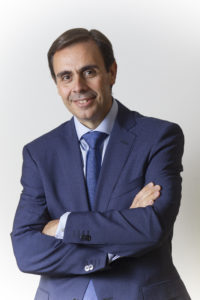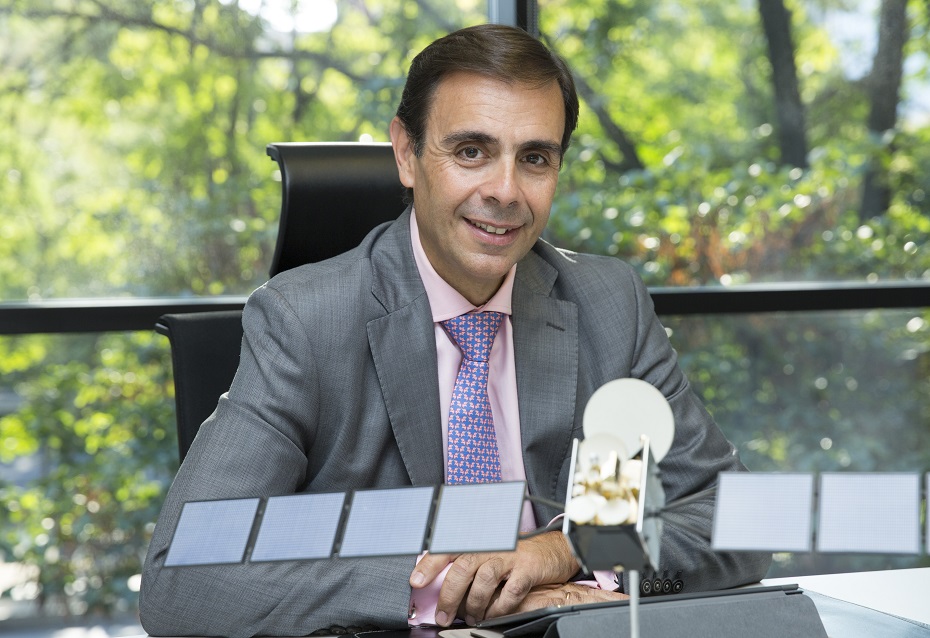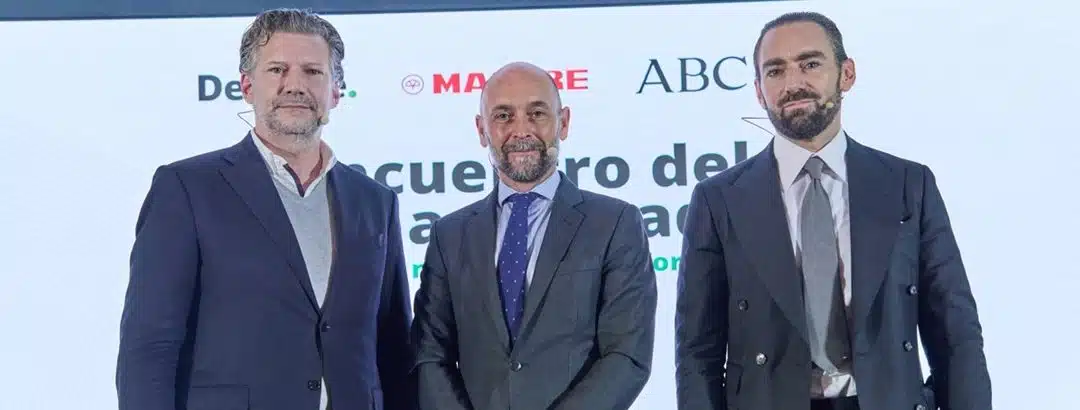admin | 05/11/2020
Juan Jesús García Chaparro, Economic-Financial Director of Hispasat, talks to us in this interview about how the company managed the continuity of its operations after the Covid-19 pandemic broke out, the important role of satellites by providing connectivity services to sectors as important as education, health or the Administration, and on future trends in its multiple applications
1. How is HISPASAT’s business currently distributed? What segments/sectors/regions do you serve?
The most efficient and extensive use of communications satellites has been traditionally associated with video services, mainly for broadcast and television signal distribution applications. In areas with limited telecommunications infrastructures, satellites have also been able to play an essential role thanks to the quick rollout of telecommunications networks within satellite coverage footprints as well as satellites acting as a connecting link with existing land networks characterized by geographic roll out limited to local or regional scopes.
Within this context, the distribution and allocation of HISPASAT’s business between video and telecommunications networks—or video and data for the sake of simplicity—was, up until three or four years ago, approximately two thirds (video) and one third (data), with greater importance for video in coverage in Europe and a more balanced distribution in coverage in Latin America.
Over the last few years, the changes that have arisen in technology, with the expansion of fiber optics and mobile networks, new media consumption habits moving from broadcast television to on-demand and OTT, and ever-present demand for connectivity have completely transformed the industry.
Today, although video services continue to be the most used and occupy most satellite capacity, future trends clearly predict a general decrease. Nevertheless, they will continue to have a relatively significant impact on how our business’s pie chart is sliced. In 2020, approximately 50% of revenue still came from video and the other 50% from data networks, where cellular backhaul (backup and expansion of mobile networks), solutions for all types of transport (rail, maritime, and aviation), and connectivity in the corporate, institutional, and government segments in rural areas and those with limited land infrastructure have promising growth outlooks and are the segments where the company is strategically positioning itself.
In geographical terms, approximately two-thirds of our business comes from the Americas, mainly Latin American markets—with Brazil as the main benchmark—and the rest of Europe and North Africa, concentrated mostly in Spain and Portugal.
2. Could you briefly describe the current situation of the aerospace/satellite industry?
As I mentioned, the industry has been subject to a significant transformation in the last few years. This can be seen in the services we currently provide, which are very different from those offered years ago. This shift has also moved into other areas, such as satellite design (which now allows for greater operational flexibility in orbit to adapt to the market’s changing needs) and launch vehicles (which in the search to reduce costs as much as possible, have begun to reuse certain modules of their vehicles).
Satellite constellations deserve special mention. They still have not achieved clear viability in their business model as shown by OneWeb’s recent declaration of Chapter 11 bankruptcy. It was one of the proposals that had garnered the most media attention and investment.
On the satellite operator side, after years of gradual adaptation to this new ecosystem, it should be noted that the sector was able to reinvent itself and, as a result, it was able to identify certain niches of opportunity where satellites are being called in to play a significant role due to their characteristics. This is the case for connectivity services in remote environments, where distance from large urban centers and limited population density make land infrastructure inefficient or even impossible to roll out. The same thing occurs in maritime and aviation environments. Land infrastructure is not able to provide services at sea or in the middle of a transoceanic flight. Nevertheless, connectivity demand is only growing among passengers.
3. What does service demand look like internationally? Are there differences between regions?
To analyze service demand trends and behavior, it’s important to explain the combination that occurs between the different business verticals and the regions under our coverage footprints.
In the transition that has been taking place in the last few years, where the sector has changed course and shifted toward data, a number of verticals have been identified in which the satellite has a great deal of potential, especially in certain regions.
For instance, transport, specifically the aviation connectivity segment, is one of the verticals with the highest potential for growth in the coming years. There are demand niches within this vertical in areas with a great deal of air traffic, such as transoceanic air corridors and areas with a high density of domestic flights, such as the United States. Our new satellite, the Amazonas Nexus, offers optimized coverage to capture demand for aviation transport services both in the United States and in the air corridors in the Northern and Southern Atlantic from their location at 61° West.
In addition to transportation services, we also offer residential and corporate broadband solutions and solutions to expand cell networks. Our coverage areas naturally have different levels of maturity in regions where this kind of service is potentially accessible from our orbital positions. This is the case for Europe, and more specifically for Spain, where a great deal of effort was made to roll out fiber optics. Nevertheless, there are other areas where potential for growth for these kinds of applications is huge, as in Latin America. There, challenging terrain and limited development of land infrastructure for connectivity solutions allow for the creation of demand for satellite services. HISPASAT’s extensive, solid presence in the region—where we have our Brazilian subsidiary HISPAMAR Satélites, as well as branches and a sales presence in countries including Colombia, Argentina, Mexico, and Chile—and its position of leadership resulting from our cultural affinity with the region position us highly in this segment.
But even in Spain, a country where fiber optics has been widely rolled out, there are still over 1,100 towns where an internet connection with a minimum speed of 30 Mbps, as set out in the Digital Agenda for Europe, is not available and thousands of homes have zero coverage. That number of towns grows significantly if you consider the 2025 Digital Agenda, which set the goal of a minimum speed of 100 Mbps. Additionally, fiber optics expansion plans refer to connected homes, but the territory in and of itself is not considered. At this particular moment when standard 5G implementation and the Internet of Things is around the corner and connections will be needed for a multitude of sensors and devices for applications to optimize work in industries including energy and agriculture, this fact reinforces the importance of the global coverage offered by satellites. In short, even in areas where fiber optics is widely used, satellite technology is now more necessary than ever to supplement those land networks.
Moreover, the arrival of COVID has entailed a remarkable shift in telecommunications usage trends: from their homes, users have heavily increased capacity consumption (largely due to audiovisual content) straining data traffic ranges that, under normal conditions, land infrastructure previously only maintained as support, with the ensuing risk of saturation. We’ll need to keep an eye out in the medium term to see if those changes are the result of exceptional need or if they are here to stay. If this exception becomes a new rule of consumption, satellites are sure to always be an immediately implementable solution to more efficiently redistribute different telecommunications uses, particularly to divert video services to the technology best suited to distribute it.

I’d like to highlight the insurance market’s great professionalism and capacity to develop and adapt the clauses of the policies we take out to provide an insurance solution adapted to the risks that we need to insure and cover.
4. The aerospace industry is known to be constantly evolving, with new kinds of satellites and launch vehicles, new services, new technology, etc. How does the industry’s constant innovation impact risk management?
Risk management has always been a constantly-evolving, dynamic process. The regular risk analysis done by risk managers should always be based on the premise of fully questioning the validity of existing risks and new exposures both due to technological evolution and the evolution of the business model itself associated with a gradual verticalization in the value chain, though they shouldn’t forget the evolution of risk in terms of regulation and finance.
In this sense, over its long history HISPASAT has shown a great deal of resilience to the side most closely related to the technological evolution, which is inherent to the characteristics of our business. As the potential risks facing each new satellite program are thoroughly analyzed beforehand (new launch vehicles and prior flight experience, new platforms or design configurations for our satellites: internal redundancies, fuel and power margins, degree of reliance on other satellites in the fleet for critical services, commitments made with clients prior to launch, etc.) an ad-hoc risk management program is designed for each satellite project. This plan transfers certain risks to the satellite’s manufacturer and the launch agency and, a “custom” insurance plan is designed according to HISPASAT’s needs for those that are retained.
Accordingly, I’d like to highlight the insurance market’s great professionalism and capacity to develop and adapt the clauses of the policies we take out to provide an insurance solution adapted to the risks that we need to insure and cover.
5. Do you think that the space industry is safer now than it was 10 years ago?
In the last few years, the space industry has substantially improved manufacturing processes and all the tests done to the satellite, both while building and in preparation for launch. All of this has contributed to increased reliability for all components that contribute to successful satellite launches and operation.
In both the flight and land segments, cybersecurity is one of the areas where the industry is especially focused so as to bolster and guarantee operations. In this line of work, without delving too deep into technical aspects that I do not feel capable of discussing, one of the top lines of research the aerospace industry is looking into around the world is quantum communications to satisfactorily respond to security challenges. This new, revolutionary technological approach with exponentially increased processing speeds will make communications satellites more reliable than land communications. This added value clearly guarantees security, e.g., on critical institutional and corporate networks.
6. Satellites have played an important role in the crisis unleashed by the pandemic. Their services have been truly fundamental in many ways. What has HISPASAT’s experience been like in these circumstances?
The pandemic was a wake-up call in terms of connectivity issues in a number of regions. HISPASAT has experienced this directly in a number of areas within our coverage footprint, especially, given their proximity, in numerous parts of Spain with their various implications that go beyond Internet access for individual households and include industries as important as education, healthcare, and government. In less populated areas of Spain, business owners have had trouble digitally transforming their businesses, workers have had a hard time working remotely, students have experienced difficulties attending online classes, and families have struggled to communicate amongst themselves. This issue, which has been discussed a great deal in the media over the last few months, has been even more severe in more marginalized regions including Latin America.
This is not a circumstantial issue to be associated with the pandemic and nothing more: it is a problem we were already experiencing that has simply become more apparent. Therefore, what we need to ask ourselves is not simply how we can get back to where we were before the pandemic, but rather how we can rid ourselves of this obstacle that was already an issue and we have simply seen firsthand now because it has been made more tangible than ever.
7. Has the pandemic affected risk management in any way? If so, how have you responded?
Absolutely. Before COVID-19 was officially declared a pandemic, the year began with turbulent, particularly volatile financial markets that were already anticipating the uncertainty caused by what was then an epidemic in China. It was transmitted incredibly quickly and spread around the globe with dramatic consequences to the health of so many people, particularly the most vulnerable groups. This situation, which has had such a major impact on everyone’s daily lives and habits, has inevitably had an impact corporate management and, naturally, HISPASAT is no exception.
Within this context, even a few days before COVID-19 was declared a pandemic HISPASAT adopted a global plan to adapt to the new scenario we are facing. It is clearly based on three points:
As the company is aware that companies run on the drive and daily work of their employees, the first and most important aspect was safeguarding and protecting the health and well-being of our employees. So, when the pandemic had already spread around the world. but the state of alarm had not yet been issued in Spain, HISPASAT recommended all its employees work remotely, except for those directly involved in the control and operation of satellites, for whom a specific plan was created.
The second, and no less important, basis for the plan was to ensure the continuity of services and operations. A specific contingency plan was developed around this point, and our operations centers’ access protocols were strengthened, control rooms were isolated in “bubbles,” and personal protective equipment was provided to all personnel working in these facilities. HISPASAT’s foresight and quick decision-making decidedly contributed to reducing the risk of transmission and keeping satellite control center operations at nominal conditions.
Finally, the third aspect was to limit the financial impact that the COVID crisis would have. The company took action along three lines while always maintaining the strict financial discipline that guides the company’s management. First, all of the company’s administrative processes were strengthened. Special attention was paid to accounts receivable, monitoring the client portfolio situation. Strict, rigorous, and austere cost control and non-critical investment measures were established. Costs that were not strictly necessary and did not entail even tangential creation of cash flow were eliminated. Finally, the company made the decision to increase its liquidity position to be prepared for any unexpected contingency that may affect the creation of recurring cash flow. This was all done on top of a previously cleaned-up balance sheet and solid financial position.
8. The crisis has made large companies change their business strategies. Has HISPASAT’s roadmap changed in terms of ongoing projects and business development? What is the short-term launch projection?
Unlike more vulnerable businesses, the satellite business is highly resistant to the kinds of situations we are currently experiencing; this is largely thanks to long-term contracts that make up a substantial part of the cash flow to be generated in the coming fiscal years, paired with the essential role of telecommunications as well as critical infrastructure for both corporations and households, especially in situations of emergency. This assertion can be confirmed by taking a look at how reasonably well telecommunications networks have handled the substantial hike in connectivity demand, supporting, for example, the high volume of traffic resulting from telecommuting and video streaming services used as entertainment during the harshest phases of lockdown.
Although the statement above is generally true, we shouldn’t hide the adverse affects this crisis is having on certain segments and verticals like the corporate networks for the oil and gas market, which have been severely impacted by the pandemic, as well as transport-related services. Aviation and maritime transport have almost completely shut down. The number of flights operating is far from the number of flights pre-COVID.
In spite of it all, we believe that this segment will continue to be one of the main drivers of the future of the industry, one that HISPASAT has strongly backed with the creation of its new Amazonas Nexus satellite, which was approved by the Board at the end of 2019 and is scheduled for launch at the end of 2022.
This satellite is designed with cutting-edge technology and an HTS (high-throughput satellite) configuration: It is mainly aimed at covering in-flight connectivity demand in the air corridors of the Northern and Southern Atlantic as well as in North America. It also includes the design of specific, on-demand payloads for connectivity services in Greenland and other capacities for our institutional and government agency clients.
The initiatives that were established for the global plan to adapt to the new scenario created by COVID that I mentioned in the previous answer include creating a specific work group to review and validate all hypotheses used as a basis for the decision to take on the Amazonas Nexus project. It concluded that the hypotheses were correct in the timeline defined for the project’s entry into service in early 2023. This decision was backed in turn by the financial market, which provided the necessary financing in the most critical phase of the pandemic in Spain.
9. What applications will satellite services have in the future? What services are considered to be the most in demand?
Beyond the certainty that broadband connectivity via satellite, cellular backhaul, and applications in transportation will be the new drivers of the sector, as I’ve indicated throughout this interview, there are also huge possibilities for the satellite industry throughout the ecosystem being developed around the world of the IoT (“Internet of Things”), as well as the significant role satellites are bound to play in 5G.
This new standard is a change of direction compared to previous generations: while older generations focused on connecting people, 5G aims to connect objects and people with other objects and people anywhere in the world. To succeed in this paradigm shift and prevent a delayed or inefficient rollout, we need to simultaneously use different fixed technologies, land infrastructures, and satellites that make the most of the functionalities most appropriate for each scenario.
Many of these IoT applications requiring low bandwidth can find a great ally in nanosatellite constellations and they can also combine their mass data collection with all the data from Earth observation satellites to offer a much more complete analysis. We believe that this combination of data and subsequent analysis is a niche with a great deal of potential for added-value solutions. In short, we believe that the future of telecommunications is shifting toward combined use of land infrastructure and satellites.
We also strongly believe that satellites are going to play a significant role in collaboration between the public and private sectors. This will be the case when guaranteeing the digital transformation of our company and society as whole, fully ensuring basic connectivity services for the population according to the quality standards set by European authorities, but it also may play a key role in the development of a secure connectivity system for governments and institutions, which is increasingly in demand in Brussels.
10. If you had to choose only four words to describe HISPASAT, what would they be?
First, I’d say HISPASAT is defined by “commitment.” Commitment to our shareholders, for whom we must have returns, grow, and add value; to our employees, for whom we offer a future full of opportunities for professional and personal development; and finally to the society at the core of everything we do.
Another word that perfectly defines us is “thorough.” We expect more of ourselves every day to improve our quality standards and we aspire to be excellent in all that we do.
Third, I’d choose “dedication” for the dedication that each and every one of us at HISPASAT enthusiastically demonstrate in our jobs every day over the course of days that can feel sometimes never-ending, yet are always enriching.
Finally, I’d choose a word that sums up the previous ones. HISPASAT is “passion.” The passion that is felt and shared by each of our 200 employees who give 110% to make their organization into a better company. One that is stronger and more unified, with veritable team spirit; one that can also be a legitimate source of pride for them to be a part of.
11. The insurance industry has been an essential player in aerospace development. MAPFRE in particular is a pioneer in the Spanish insurance industry and has been very involved with HISPASAT for quite some time. Could you briefly describe how this involvement between the two companies has evolved and how you see it progressing in the future?
The bond between MAPFRE and HISPASAT dates back to the very beginnings of the HISPASAT project.
Among the different working groups that were organized to roll out a trailblazing project in Spain in the late 1980s, the insurance group was founded so that the company’s most noteworthy shareholders could leverage their experience in this field and support the company in design and to define the risks associated with a satellite program and the insurance options, which did not then have comparable benchmarks that would allow for even an estimated working model.
That working group also included participation from high-standing professionals such as Paola Serrano and Ignacio Martínez de Baroja, and key shareholders including Postal Seguros Generales, representing Caja Postal, Telefónica’s Risk and Insurance Management arm representing Telefónica, and MUSINI, which was subsequently acquired by MAPFRE, representing INI, another founding shareholder of HISPASAT.
In the end, professional relationships between companies are built by the people who represent them. Accordingly, I’d like to take advantage of the occasion provided by this question to highlight and recognize the great personal and professional harmony we’ve had with the people at MAPFRE who have been committed to doing their best to strengthen the bond between HISPASAT and MAPFRE from the very beginning. I would be remiss not to offer special thanks to Alfredo Arán, Paola Serrano, who I previously mentioned, and Cristina Quintero for their support, dedication, and commitment to HISPASAT in the insurance programs for each of the satellites we’ve launched into orbit and also for their claims management services. Some of these claims were quite complicated and MAPFRE has always taken a constructive stance and been by HISPASAT’s side to reach agreements that are reasonable for everyone.
Given our past, I truly believe that the foundation for the new projects we are working on is truly solid enough to allow us to predict that the relationship and collaboration between MAPFRE and HISPASAT will only get stronger for many years to come.
 Juan Jesús García Chaparro
Juan Jesús García Chaparro
Chief Financial Officer of HISPASAT





